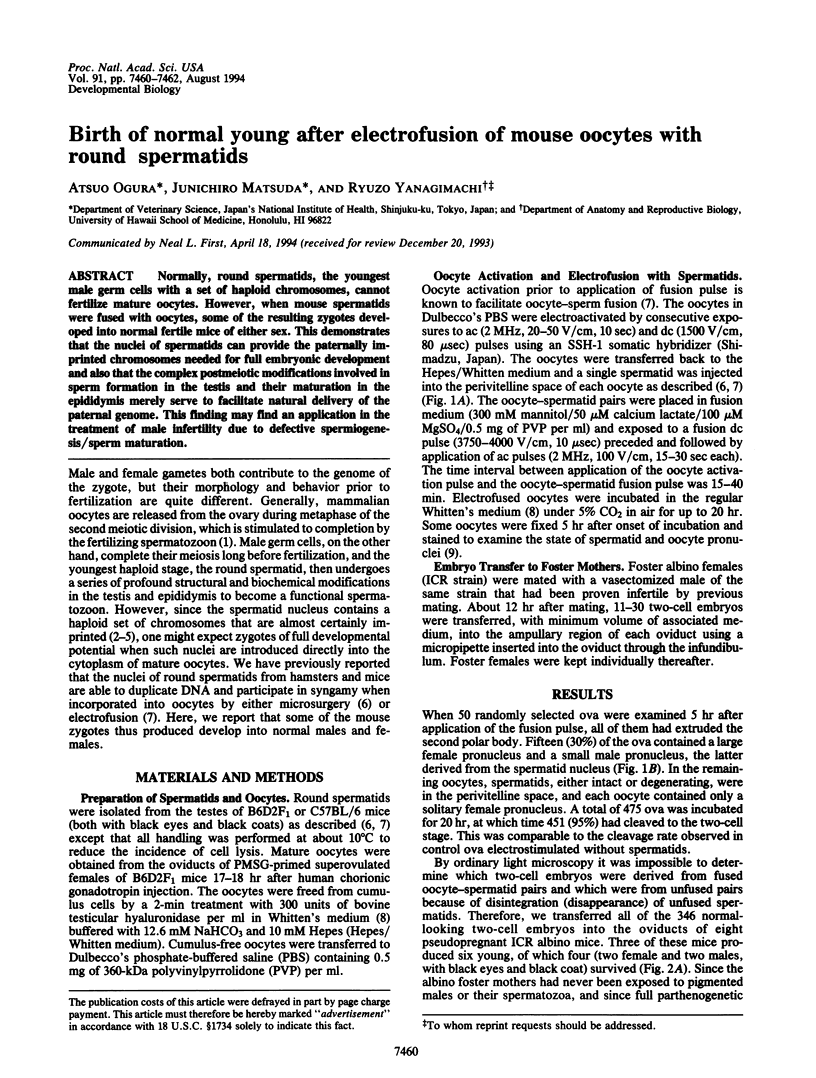Abstract
Normally, round spermatids, the youngest male germ cells with a set of haploid chromosomes, cannot fertilize mature oocytes. However, when mouse spermatids were fused with oocytes, some of the resulting zygotes developed into normal fertile mice of either sex. This demonstrates that the nuclei of spermatids can provide the paternally imprinted chromosomes needed for full embryonic development and also that the complex postmeiotic modifications involved in sperm formation in the testis and their maturation in the epididymis merely serve to facilitate natural delivery of the paternal genome. This finding may find an application in the treatment of male infertility due to defective spermiogenesis/sperm maturation.
Full text
PDF


Images in this article
Selected References
These references are in PubMed. This may not be the complete list of references from this article.
- Barton S. C., Ferguson-Smith A. C., Fundele R., Surani M. A. Influence of paternally imprinted genes on development. Development. 1991 Oct;113(2):679–687. doi: 10.1242/dev.113.2.679. [DOI] [PubMed] [Google Scholar]
- Chandley A. C. The chromosomal basis of human infertility. Br Med Bull. 1979 May;35(2):181–186. doi: 10.1093/oxfordjournals.bmb.a071567. [DOI] [PubMed] [Google Scholar]
- McGrath J., Solter D. Completion of mouse embryogenesis requires both the maternal and paternal genomes. Cell. 1984 May;37(1):179–183. doi: 10.1016/0092-8674(84)90313-1. [DOI] [PubMed] [Google Scholar]
- Monk M. Genomic imprinting. Genes Dev. 1988 Aug;2(8):921–925. doi: 10.1101/gad.2.8.921. [DOI] [PubMed] [Google Scholar]
- Ogura A., Yanagimachi R. Round spermatid nuclei injected into hamster oocytes from pronuclei and participate in syngamy. Biol Reprod. 1993 Feb;48(2):219–225. doi: 10.1095/biolreprod48.2.219. [DOI] [PubMed] [Google Scholar]
- Ogura A., Yanagimachi R., Usui N. Behaviour of hamster and mouse round spermatid nuclei incorporated into mature oocytes by electrofusion. Zygote. 1993 Feb;1(1):1–8. doi: 10.1017/s0967199400001234. [DOI] [PubMed] [Google Scholar]
- Rao M. M., Rao D. M. Cytogenetic studies in primary infertility. Fertil Steril. 1977 Feb;28(2):209–210. [PubMed] [Google Scholar]
- Retief A. E., Van Zyl J. A., Menkveld R., Fox M. F., Kotzè G. M., Brusnickỳ J. Chromosome studies in 496 infertile males with a sperm count below 10 million/ml. Hum Genet. 1984;66(2-3):162–164. doi: 10.1007/BF00286592. [DOI] [PubMed] [Google Scholar]
- Sulewski J. M., Dang T. P., Ferguson K. A., Ward S. P., Ladda R. L. Chromosomal abnormalities associated with infertility. Obstet Gynecol. 1980 Apr;55(4):469–475. [PubMed] [Google Scholar]
- Wassarman P. M. Fertilization in mammals. Sci Am. 1988 Dec;259(6):78–84. doi: 10.1038/scientificamerican1288-78. [DOI] [PubMed] [Google Scholar]
- Yanagida K., Yanagimachi R., Perreault S. D., Kleinfeld R. G. Thermostability of sperm nuclei assessed by microinjection into hamster oocytes. Biol Reprod. 1991 Mar;44(3):440–447. doi: 10.1095/biolreprod44.3.440. [DOI] [PubMed] [Google Scholar]



